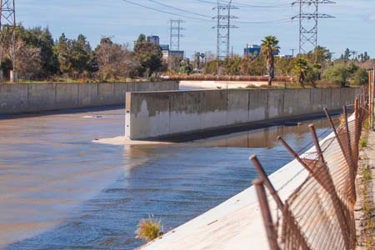Testing The (Storm)Waters

By Kevin Westerling,
@KevinOnWater

Heavy rains in California prove the worthiness of the “sponge city” concept.
Water scarcity and flood management are two of the biggest issues facing industry professionals across the U.S. and around the world, but quite often we think of those challenges as regional and separate — the arid West vs. the water-logged Northeast, for example. But in California, they must deal with both extremes, thanks to long stretches of drought interrupted by periods of intense rainfall that can be too much to handle, especially in urban areas — a cruel irony of sorts. (“How about some rain and not all the rain?”)
From crisis comes opportunity, however, and California is adapting to the seemingly new normal by capturing the deluge and saving it for a non-rainy day. In doing so, they provide proof of concept for other cities that, with climate change effects ongoing, will need to adapt similarly. The concept is that of a sponge city — one that favors permeable and green surfaces over impermeable and gray — to solve two problems at once. Such an approach wasn’t always necessary for cities that were built on old desert ground, but that was before the term “atmospheric river” came into common parlance.
Cry Me A River
Atmospheric rivers are bands of moisture, typically long and narrow, that vary in strength and size but have the capacity to hold — and release — tremendous amounts of rainwater. According to the U.S. National Oceanic and Atmospheric Association (NOAA):
“[T]he average atmospheric river carries an amount of water vapor roughly equivalent to the average flow of water at the mouth of the Mississippi River. Exceptionally strong atmospheric rivers can transport up to 15 times that amount.”
The reason we are becoming more familiar with the term is because the phenomenon itself is happening more frequently because of climate change. According to Wired1, “for every 1 degree Celsius of warming, the atmosphere can hold 6 to 7 percent more water, meaning there’s often more moisture available for a storm to dump as rain.”
So, yes, they will only become more potent as temperatures rise.
Soaking It In
As an example of current conditions, Wired noted that early February’s atmospheric river in Los Angeles “dumped 9 inches of rain on the city over three days — over half of what the city typically gets in a year.”
But, because of the city’s ability to capture much of it, perhaps we can lose the pejorative and say that it supplied 9 inches of rain over that time. Per the article, “between February 4 and 7, the metropolis captured 8.6 billion gallons of stormwater, enough to provide water to 106,000 households for a year.”
Traditional dams and catchments also played their parts, to be sure, but Los Angeles was not and could not be in the position to manage — and leverage for future use — huge, atmospheric-river levels of rainfall prior to the incorporation of both green spaces (gardens, swales, etc.) and brown spaces — constructed “spreading grounds” to which stormwater can be diverted to form dirt basins, eventually percolating down to the aquifer.
In addition to saving water and averting floods, spongier cities also ease the burden on treatment plants that don’t have the capacity to take on ever-escalating volumes of stormwater, thereby averting pollution events.
The takeaway is that the times, and the weather, are changing. In times past, it may have been true that only areas with frequent rain were candidates for these measures. Now, as proven in Los Angeles, it seems that nearly every city is, as Elaine Benes would say, sponge-worthy.
References:
